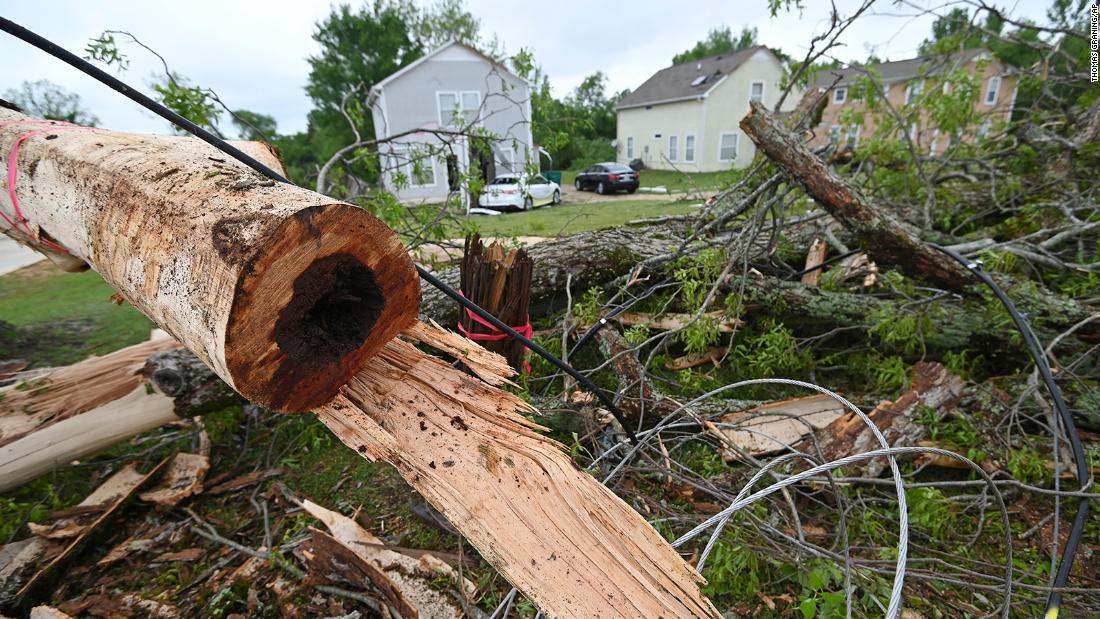After a quiet night, Tuesday is expected to bring severe weather to the southeastern United States, which has already been hit by deadly tornadoes.
A storm system moved from Oklahoma and Texas, where more than 36,000 people were without power early Tuesday, according to PowerOutages.us, and to the Lower Ohio Valley area and Tennessee. The afternoon brought diminished downpours and gusts of wind, but dawn threatens to bring severe weather again.
Large hail, damaging wind gusts and tornadoes are forecast to impact areas from the Ohio River Valley to the Gulf Coast.
As the day progresses, the heat and humidity that accompany May in the Deep South will help revitalize the atmosphere and areas along the Gulf Coast from East Texas to the Florida Panhandle could see Strong to severe storms appear until the arrival of the strong gusts that come with the advance of the front.
Central Louisiana, Alabama, Georgia, and Mississippi areas are more likely to experience hail impacts and damaging straight-line winds than tornadoes. But tornadoes are still possible.
These can be just as damaging to a region already recovering from the storms that hit the state in recent days.
On Sunday, tornadoes hit at least three Mississippi cities. On Monday, tornado and thunderstorm alerts spread from Mississippi to south-central North Carolina, including the Atlanta metropolitan area, where a tornado made landfall and caused widespread damage.
Just over 90 million people could experience severe weather on Tuesday. About 28 million in the Southeast could face the fury of rain, lightning, hail, wind and possible tornadoes.
A split tree stands on the side of Elvis Presley Drive in Tupelo, Mississippi, on Monday.
Georgia’s weather turns deadly
The region is still recovering from the weather that killed two people in Georgia.
A Houston County resident died as a result of the weather that struck Monday, the Houston County Emergency Management Agency said in a news release. The 55-year-old woman died when a tree fell.
“When Fire Department crews arrived, they found that a large pine tree had fallen into the living room area of the house, causing substantial damage to the roof and exterior walls. Tragically, teams also discovered that 55-year-old Ms. Carla Harris was struck by falling from the tree and suffered fatal injuries, ”according to the Houston County Emergency Management Agency news release.
More than 100 miles away, a man in Douglassville, Georgia, also died after a tree fell on his car when a tornado made landfall Monday.
The Douglas County Fire Department responded to reports of a tree in a car with a person inside around 10:36 a.m., according to a news release from county officials.
“When they arrived at the scene, they discovered that the driver was trapped inside the vehicle with electrical wires and a tree in the vehicle,” Douglas County Communications Director Rick Martin said in the statement. “The firefighters had to remove the driver that we only identify as male at this time until family members are notified.”
Atlanta Mayor Keisha Lance Bottoms tweeted photos of downed trees in her southwest Atlanta neighborhood, while Dru Ghegan, owner of Bonded Service Warehouse in Fulton County, shared photos showing the building sustained significant damage.
The storm caused significant damage to Dru Ghegan’s warehouse. He said no one was hurt.
Rainy days could mean flash floods
Many Southeastern states have seen twice their normal rainfall in the past month, so even an additional 2.5 to 5 centimeters of rain could lead to flash flooding.
Flash floods will be possible across the south thanks to the combination of heavy rains and all the rain that has fallen in recent days and weeks. Widespread 2.5 to 7.5 centimeters rain is forecast in this region through Tuesday night.
“There are likely to be large hail, damaging wind gusts and some tornadoes along with rainfall rates of more than 2.5 cm per hour,” said the National Weather Service office in Jackson, Mississippi.
Rounds of thunderstorms and rain showers will traverse the Ohio and Tennessee river valleys throughout the day Tuesday. Further south, scattered midday storms are likely to develop from eastern Texas to Georgia.
This storm line should weaken on Wednesday morning as it approaches the east coast, but isolated severe weather will remain possible.

